Polish Chicken – 3 Must Do Special Care Tips
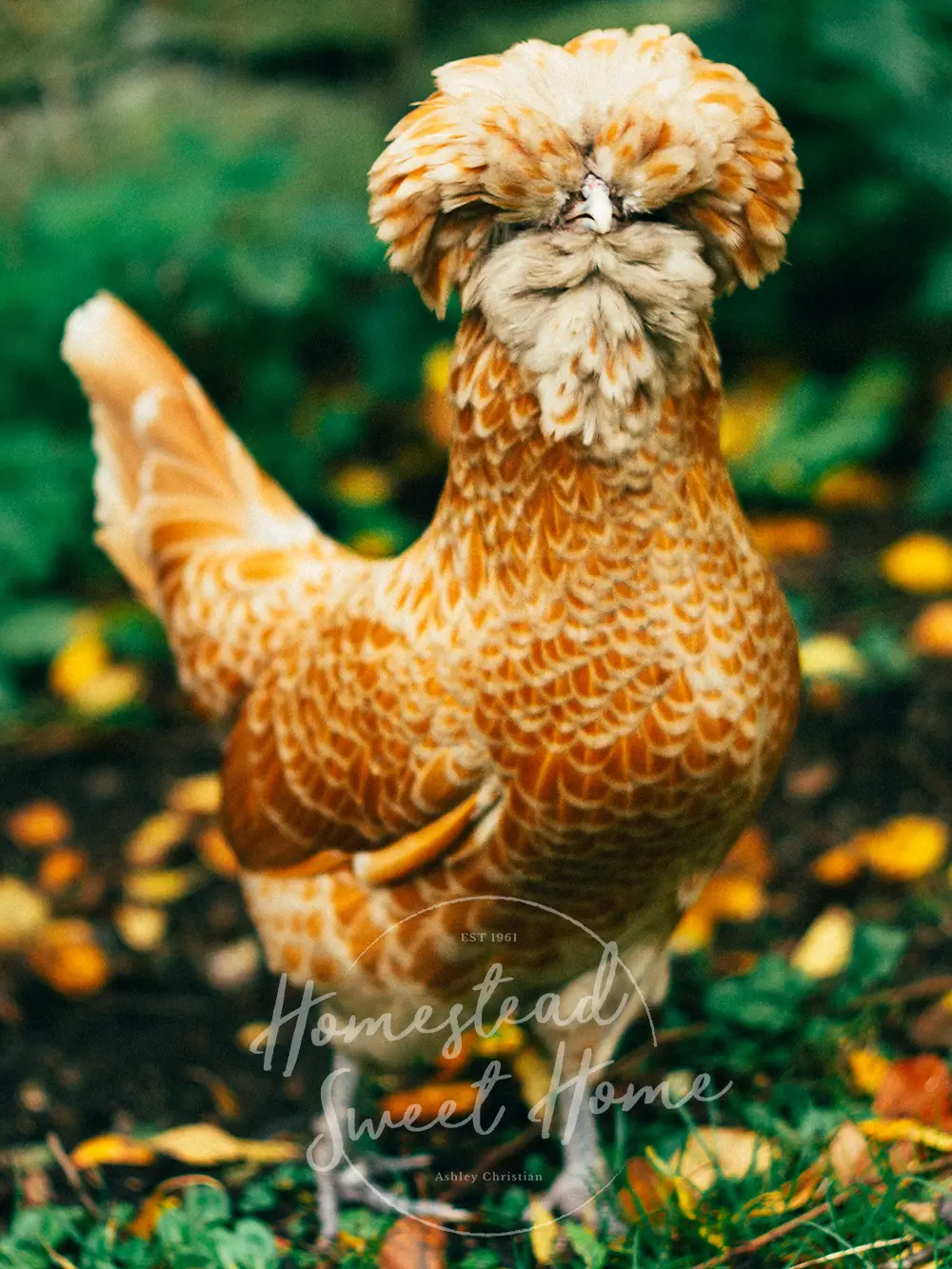
Polish Chicken Quick Facts
- Known for: puffy feather crest on top of their heads, and a very cuddly but anxious and timid personality, entertaining to watch
- Temperament: anxious and loving, easily picked on by other breeds
- Eggs: 200 medium white eggs each year
- Meat: poor—reaches maturity at 20 weeks with 6 lb males and 4.5 lb females
- Climate: Excellent heat tolerance and poor cold tolerance
- Broodiness: rarely will the Polish chicken set on eggs
Polish Chicken Overview
The Polish chicken is known for its large feathered crest and sweet, docile personality. Polish chickens have a calm temperament and are not aggressive towards humans or other animals, unfortunately, they are overly timid and anxious and are frequently picked on by other breeds. They are heat-hardy so they can be raised in hotter climates than other breeds of chickens, though they don’t do as well in very cold climates.
Polish chickens will lay 200 medium white eggs each year. Polish chickens have relatively poor meat production and are best kept as an ornamental breed for their beautiful feathers and sweet personalities. Many backyard chicken farmers who have Polish chickens, keep them in a separate coop from their other breeds of chickens so they don’t get picked on and can live in peace.
Pros and Cons of Polish Chickens
- Pros: Beautiful colors and big feathered crests on top of their heads, loving temperament, entertaining to watch, lay twice as many eggs as other ornamental breeds like the silkie chicken
- Cons: Feathered crests make it difficult for them to see, so they can be timid and slow to hide from predators, they are the bottom of the pecking order in a mixed breed flock, they do not make good meat birds, they don’t go broody, and they are flighty and noisy which may not work in a small yard
Polish Chicken Appearance
- Size: Medium-sized birds 4.5 lb females and 6 lb males
- Color: White, white-crested black, silver, buff laced, blue, splash, and golden
- Egg Color: Polish chicken eggs are white in color
Polish chickens are some of the most beautiful ornamental chicken breeds you can find. The large crest on top of their heads gives them a distinct look like no other. They have lovely feather color patterns and beautiful splashes of color and beautifully shaped bodies.
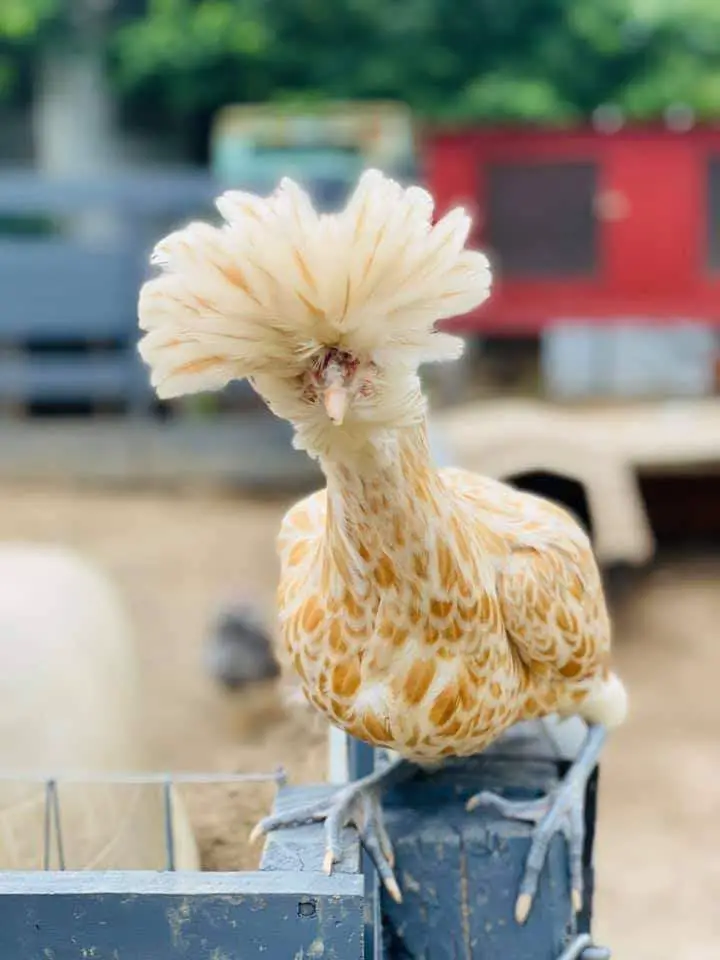
Polish Chicken Egg Production
Polish chickens are not prolific egg layers and will lay a moderate amount of eggs—about 200 eggs per year. Because the Polish chicken does not go broody, this will help increase her egg production. Their egg’s size ranges from small to medium and is white in color. Hens will reach full maturity at 20 weeks, and they should start laying shortly after. To keep your birds healthy and productive, keep their coop and run clean. You can also give them a separate bowl of oyster shells or crushed eggshells to consume as desired. These supplements will provide the extra calcium they require to lay eggs as well as possible.
Polish Chicken Meat Production
The Polish chicken is not a breed that most people would choose as a dual-purpose or meat bird because they are small and not meaty. While you certainly could butcher a polish chicken for meat, they are best suited for looking good, and you’d likely be better off selling them for a good price.
Polish Chicken Broodiness
The Polish chicken will very rarely go broody and sit on a clutch of eggs. This does have its benefits as it keeps them laying more eggs, and they are always available to cuddle. If you want to hatch fertilized Polish chicken eggs, your best bet would be to purchase an incubator that automatically turns your eggs, and controls the temperature and some models even control the humidity. Likewise, if you have a broody hen or a Silkie chicken you can always place your fertilized Polish chicken eggs under her and let her do the work for you.
Because Polish chickens are such a beautiful, ornamental breed that sells for a high price, some backyard farmers have created small businesses hatching and selling Polish chicks.
Polish Chicken Temperament
The Polish chickens have dynamic personalities. They can be cuddly and sweet, anxious and timid, flighty and noise, and entertaining to watch. Because the feather crests on their head often grows to completely cover their eyes, they tend to not be able to see well.
Having limited visibility is what can make this breed anxious and timid. We would be too if we couldn’t see! Sadly and adorably their lack of vision can cause erratic, entertaining behavior like running into things or appearing unintelligent.
Even with their somewhat timid personalities, they love to be held and will often fall asleep in your arms. They make excellent pets, especially for children. They are good foragers, and because of their small size they are quick, so they will come running for treats. Due to their low visibility, many Polish chickens know their owners by the look of their shoes rather than looking up at them.
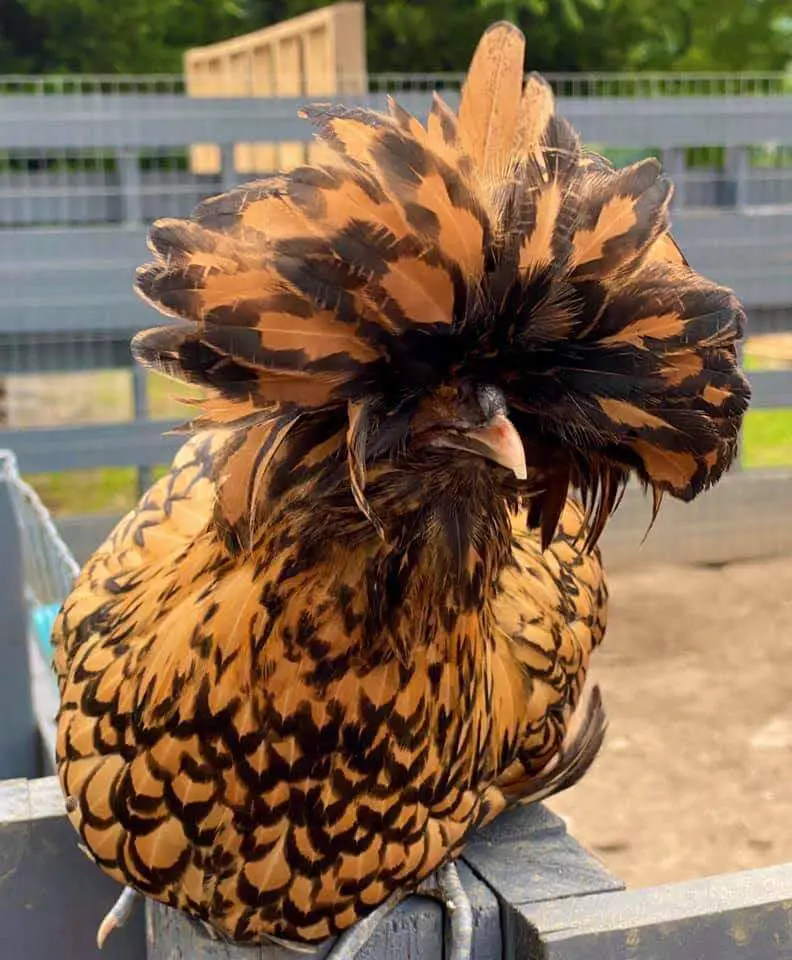
Polish Chicken Noise Level
Polish chickens are exceptionally noisy and love to talk with their owners. If you have a small backyard, noise ordinances in your neighborhood, or sensitive neighbors, the noise level of the Polish chicken will likely be too much. If you’re determined to keep Polish chickens and are worried about the noise, keep a small flock of only hens, and try to sweeten the deal with your neighbors by sharing some of your fresh eggs.
Polish Chicken Care
- Polish chickens will need some special care because of their feathered crests and lack of visibility. Though most Polish chicken owners leave the crest as is because it’s both adorable and entertaining, you do have the option of keeping it trimmed. If this is the case you can occasionally trim the feathers around their eyes with pet grooming scissors.
- Another special care consideration for Polish chickens is keeping their large crests dry and warm in the winter. If a Polish chicken’s crest gets wet in freezing temperatures, their crest will freeze making them very uncomfortable and potentially even sick. To keep your Polish chicken dry, you’ll want to be sure their coop area is weather and waterproof, and try a nipple watering system rather than a trough waterer.
- You will also want to keep the coop and run clean and free of manure build-up and soiled bedding. Because of their muffs and beards, Polish chickens can pick up and carry more dirt and potentially bacteria, so make cleaning a weekly priority. You can also get your chicks vaccinated or use medicated chick starter, and put a few teaspoons of apple cider vinegar in their plastic waterer to boost their immune systems.
To learn more about how to take care of your Polish chickens, read our Ultimate Guide to Taking Care of Chickens.
Polish Chicken Housing
Polish chickens will need four square feet each inside their coop, and fifteen square feet each in their run.
Because Polish chickens can’t see well, they are more likely to succumb to predators. You will need to be on your A-game as you protect them. It is best to keep them in a safe, enclosed run, use a chicken tractor for limited free-ranging, or use a trained livestock guardian such as a Great Pyrenees, donkey, or alpaca.
Another consideration is that you will likely need to keep Polish chickens separated from other breeds because they are very likely to end up at the bottom of the pecking order. Thankfully Polish chickens tolerate confinement well and because of their lack of visibility, it is often safer for them.
Polish chickens are flighty and love to roost. Make sure to provide each Polish chicken with eight inches of roosting space. Your hens will need about one nesting box for every three hens so they don’t get too crowded and a good size for a nesting box is 12×12 inches.
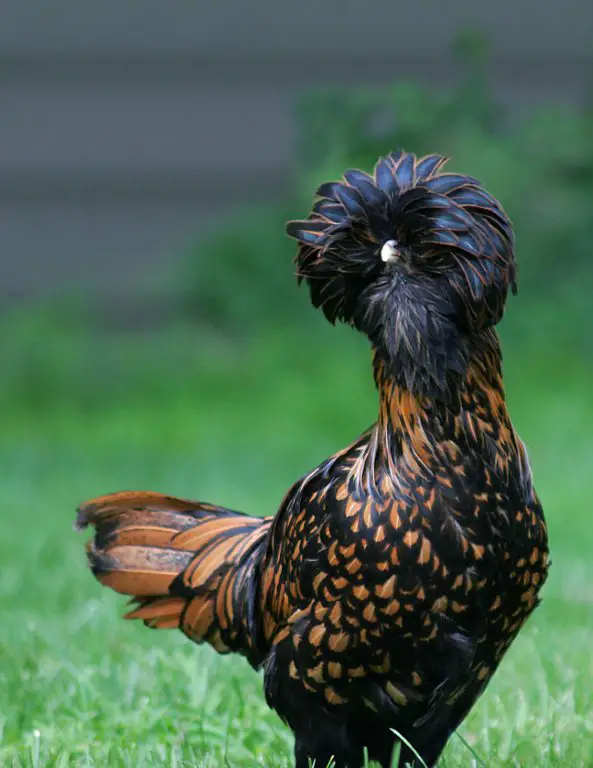
Feeding Polish Chickens
Polish chickens can be given standard chick starter from hatching till they begin laying around 20 weeks. Once your hens begin laying, you can give them standard layer feed that contains 16% protein and added calcium to keep their eggshells healthy and strong. Roosters can eat the same feed as the hens.
You may give your Polish chickens as much free-roaming space to eat plants and bugs as you can safely provide them. They’ll also enjoy kitchen scraps (though there are some that are harmful, so avoid avocados, dried beans, junk or rotten food, green potato skins, citrus, onions, or tomato or potato leaves from the garden.) Giving them this variety will not only help you save money on food but will also keep your Polish chickens healthy and entertained which is important because they are curious birds and often live in more confined spaces.
Offering Polish chickens grit is important for their health. Since chickens don’t have teeth, they need fine gravel or coarse sand in their gizzards to digest their food. Free-range chickens can usually naturally find this, but if your polish chickens don’t have access to pebbles, sand, or fine gravel, you’ll want to offer some supplemental grit.
Chicken scratch is also an important supplement to offer to Polish chickens who are confined to a run or small space. Scratch is a mixture of whole grains that stimulates pecking and scratching behaviors which are soothing to chickens.
Chicken Treats: You don’t HAVE to give your Polish chickens treats, but it’s a lot of fun! Mealworm and black soldier fly larva treats are excellent snacks for chickens that you can get from the feed store.
What is it like to own a Polish Chicken?
The best part about raising Polish chickens is how entertaining they are! Your Polish chickens will love to follow you around the yard and talk to you. They love to cuddle and will often fall asleep in your arms. They are also very flighty and jumpy, so it’s fun to watch them hop and jump around with their big feathered crest flopping back and forth or blowing in the wind.
The laughs that Polish chickens will bring you will make up for all the problems their extra head feathers cause. Polish chickens can be a bit dramatic, and not very clever at times. Most Polish chickens will also love to perch on your shoulder.
Many Polish chicken owners have trouble when their Polish is mixed in with other breeds because they are picked on and often killed by the other chickens, so this is something to consider. From a standpoint of raising your own food, Polish chickens don’t make much sense as they are moderate egg layers, poor meat birds, and often need a separate coop. But they are bringers of joy, entertainment, and slow living for their owners, which makes raising Polish Chickens more than worth it.
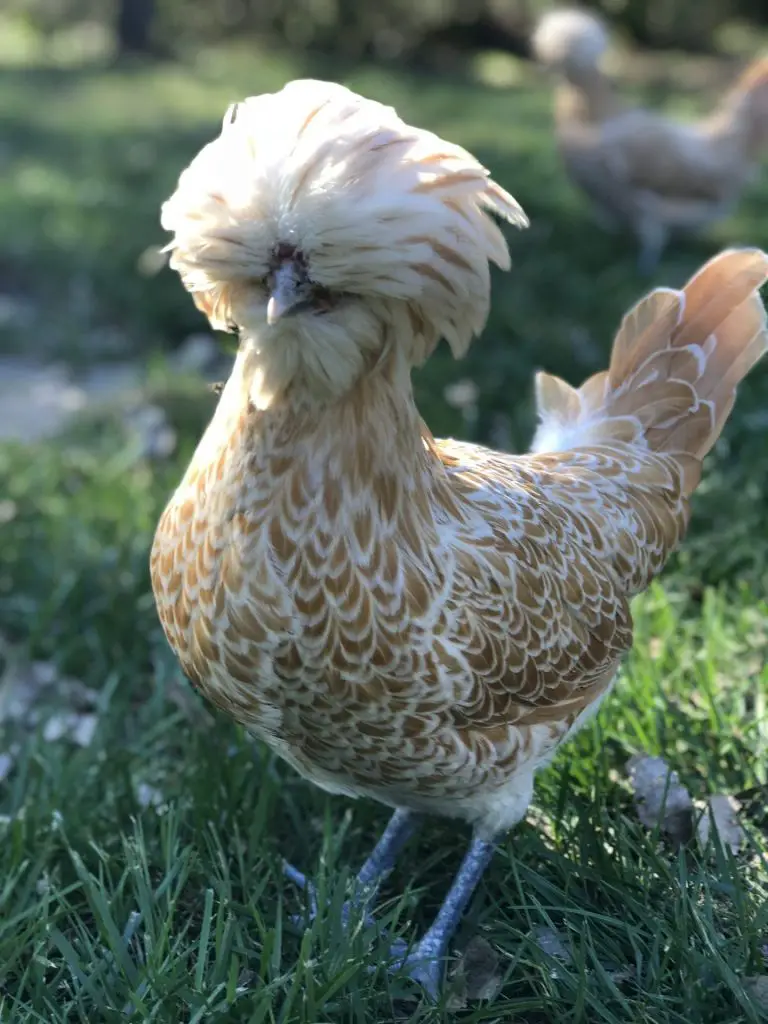
Polish Chicken Breed History
The Polish chicken is an ancient breed and despite the Polish in its name, its exact origins are unknown. Dutch barnyard paintings of these adorable chickens from the 15th century, make Holland the most likely country of origin. They were beloved by the French and all over Europe.
In the 1700s the Polish chicken was brought to England for its egg-laying abilities and beautiful exhibition-worthy head feathers. The Polish chicken made its way to America and was recognized by the American Poultry Association in 1874.
Summary
Polish chickens are beloved by many small backyard farmers and make the most exquisite show birds. Though they are poor meat producers and moderate egg-layers at around 200 eggs each year, they are a delight to have around because of their sweet and silly personalities. They are the most fun chicken breed to watch with the large plum of feathers covering their heads and often their eyes as well.
Their inability to see well because of their feathers makes them anxious and easy targets for other chicken breeds and predators. To combat these downsides, you can trim their head feathers out of the way of their eyes with pet grooming scissors, and keep them in a separate coop and run. As long as you follow these special care tips for Polish chickens, they will bring you endless amounts of entertainment, cuddles, and joy.
Do you own Polish chickens? Let us know in the comments below what your experience has been.

2 Comments
Alpacas are a prey animal and should not be used as a livestock guardian animal! They need to be guarded by true livestock guardians! Llamas may be used in this way, but never alpacas! Please do not encourage people to use alpacas as guardians.
I have a very sweet rooster with a white top and body has black and emerald green feathers. Named him Dillon. He is very handsome.